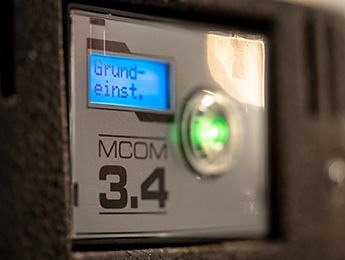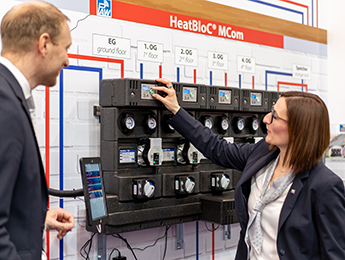Hydraulic balancing of the distribution manifolds
Our HeatBloC® MCom product series are equipped with an electronic control of the differential pressure. The MCom controller measures the differential pressure between the flow and
the return and appropriately presets the revolution speed of the pump via a PWM signal. The resulting decoupling of the consumer circuits of the generator circuit means that the
flow rate in the consumer circuit is only influenced by the thermostatic valves, i. e. the heat demand. Modifications of the pressure loss in the generator circuit by a change of
the mixing valve position or of the total flow rate are automatically adjusted. The automatic, dynamic balancing of the distribution manifold avoids the mutual influence of the
heating circulations. The high valve authority of the thermostatic radiator valves results in a stable control behaviour of the latter. Compared to a mechanical differential
pressure controller, a HeatBloC® MCom saves at least 50 % of pump energy with the same additional costs, while assuring the same comfort.
Hydraulic balancing of the radiators
The HeatBloC® MCom supports you when you carry out the hydraulic balancing, whether with preset thermostatic valves or with dynamic valves. Preset thermostatic valves are usually
set to a differential pressure of 100 mbars, dynamic thermostatic valves need a minimum differential pressure of for example 150 mbars. Just set the corresponding value at the
controller and start the hydraulic balancing. Alternatively, our PAW Connect app supports the metrological, hydraulic balancing of the radiators. Therefore, all you need are
restrictable radiators and our communication set. The communication set establishes its own WLAN and serves as an interface between the MCom controller and the app. Thanks to the
newest pump technology from Grundfos, which is implemented in the UMP3 and in the UPMXL, you don't even need a flow rate sensor. The pumps are used in heating circuits with the
nominal diameters DN 25 and DN 32 (UMP3) as well as DN 40 (UPMXL).
Step 1: Installation & data acquisition
Record all heated rooms and enter the standard heating load, the desired inside temperature and the standard thermal output of the radiators. The balancing of the distribution
manifolds is the basis for the balancing of the radiators. With the completion of the installation and the acquisition of all important data, the balancing of the distribution
manifolds works automatically.
Step 2: Balancing of the radiators
The app supports the balancing of the individual radiators. For this purpose, take your smartphone with you to the radiator and reduce it to the specified value.





